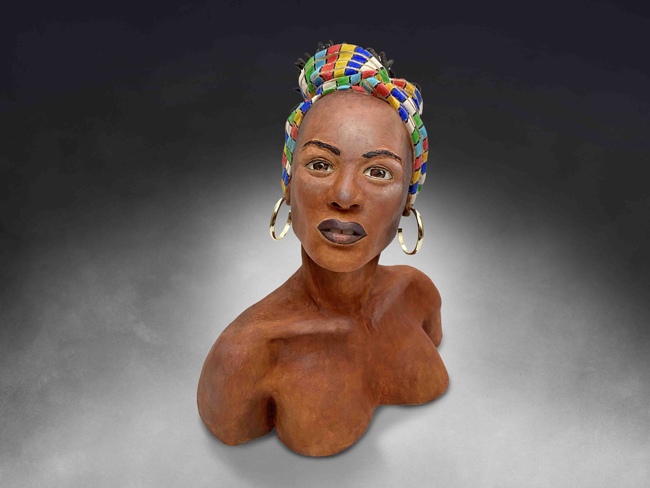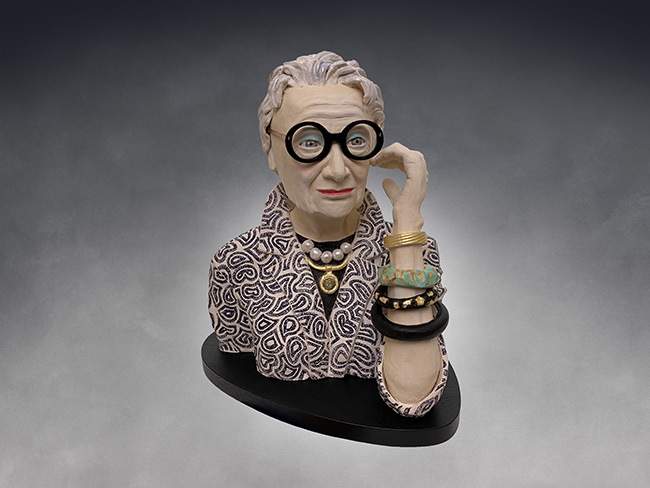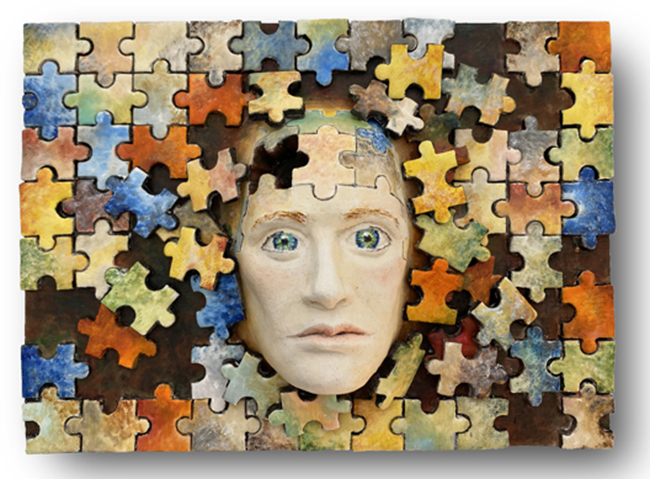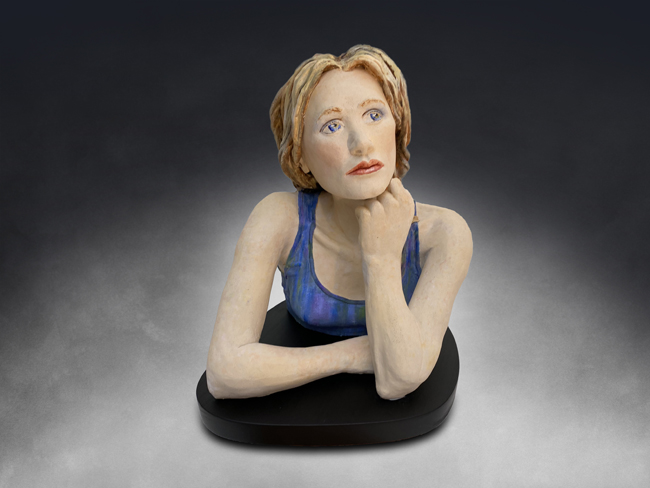Linda Wren, bringing clay to life

What is the inspiration for your work? I guess you could say I found joy in creating joy. My first figurative sculpts expressed joy and humor. And I love the challenge of creating different expressions. A slight tilt of the head, the glance of eyes, an upturn in a lip all can create an array of emotion. I love the feeling of watching the clay come to life and a personality emerge.
So inspiration may start with a chosen expression or feeling to convey. For example, in ‘Here Comes the Sun’, I wanted to try to convey the feeling of being at the beach as the sun rises above the horizon. Before I start a sculpt, I have all my reference images collected—different angles of a subject, muscular notations of a pose and expression, hairstyle, clothing style, colors selected.
Nature is also a big inspiration and a distraction. I can be on a walk with a friend and stop to admire the way ivy catches the light or the way vines tangle around a tree.
How did you get started in figurative sculpture? It was not until the seclusion of Covid, that I started figurative sculpture. I had previously taken occasional ceramic classes at the Visual Arts Center in Richmond, Virginia and made functional pieces. When the studio closed for Covid, I still wanted to work in clay, but didn’t have access to a wheel so I started hand building the figures at home. Sculpting rekindled my passion for art and I have not looked back.

Your career was advertising? Yes, for 40+ years I worked in a two-dimensional space, designing ads for such companies as Nike, Seiko, and Mercedes. I worked at numerous ad agencies in Richmond, including as Vice President and Senior Art Director of The Martin Agency.
You say you rekindled your love of art. When did the love start? As long as I can remember I was interested in art. In Elementary School, I sat next to Steve Kelly, who is now a nationally syndicated cartoonist. He would doodle cartoons in class, while I would sketch realistic renditions. My parents encouraged my artistic interests and enrolled me in many summer art classes at nearby museums and colleges.

My mom was a big influence as she had been a fashion illustrator in New York … before photography was used in ads. At age eight I was ‘dragged’ through the major museums in Europe. I say ‘dragged’ because … hey… I was just a kid and I got tired of seeing all those stone sculptures … so at some point, my dad agreed to take me to zoos while my mom went with my older brothers to museums. Years later, one of my brothers, an artist, acted as our museum tour guide on another trip to many countries in Europe. To hear him describe the paintings as though they were old friends really brought the art to life.
To get into graphic and industrial design college, I needed a portfolio. My High School art teacher, and all-time favorite teacher, assisted in that endeavor but encouraged me to be a fine artist. I feared a lack of sustainable income as an artist. At Carnegie Mellon we had 2 years to either choose graphic or industrial design as our major. It was a difficult decision, but ultimately chose graphic design and received a Bachelor of Fine Arts.
So it was a long hiatus from then till now – away from fine art. Creativity, however, has always been a part of my life, in advertising and the way I solve problems.
Who are your major influences? There are many sculptors and artists I admire for different reasons. Some sculptors for their accurate anatomical proportions, something I endlessly try to master. There are painters I admire for their use of color.
But the real influencers are the people who taught me to observe things in a penetrating way were my mom, my brothers, and my high school art teacher. Thus I find beauty in nature, simple details and individual characters.

How do you choose your subject matter? I choose my subject matter based on the emotion or expression I want to convey. Each sculpture is a personal challenge for me to try something new.
As a designer, color, pattern and texture are all important to me. Plus all these elements add to the character’s story. The yellow polka dot suit on ‘Marybelle’ place her in the 50s. The gloves say ‘upper crust’ and country club. The caption: ‘Twas the 50’s. Everything prim and proper at the club. Until, of course, it wasn’t. The expression of surprise...well, I leave that up to the viewer as to what caused her to be aghast..
My ‘ceramic canvases’ are a mix of 2 dissimilar subjects. I like to think of as human and nature, or human nature. For example: ‘Inertia’ is a combination of human and nature — the leaves, but also human nature. Inertia is something we all experience at some point in out lives, when we find ourselves in a rut and need to change things up.
The one entitled ‘Forever a work in progress’ is not so much about nature, rather human nature. We all are a ‘work in progress’ and forever evolving. If you are not evolving, well then you are in inertia.
‘Entanglement’ is both human and nature. The fractal pattern is found in nature and entanglement is also something most experience — human nature. When someone or something ensnares you, good or bad.
How did you develop your technique? Trial and error. I tried using ceramic glazes, but I could not achieve the depth of color I desired. So I tried using acrylic on ceramic and found the colors absorbed better into the ceramic if I only fired to bisque rather than vitrification.
I tried creating the head and bust all together as most sculptors do, but often wanted the head to tilt. And that can not always be predetermined. Thus, I found it better to create the head separately and then place it on neck and body to achieve more emotion with slight head tilts. So basically I am constantly modifying and adapting to achieve end results. My greatest challenge is to figure out how to create delicate details without sacrificing the strength of the overall piece.

You write stories for your characters. Yes, very short stories. The same stories I conjure up in my mind when I am creating them. Do they have an attitude? What kind of attire would he or she wear? Would they be seen in pink? How would they wear their hair? Their personality dictates those decisions. Of course, viewers are welcome to create their own story for any character that amuses them.
What have people said about your art? A common reaction is how much emotion I capture in clay. The time I put into creating detail is also observed.
Cigar magazine said “Ceramics has enjoyed a resurgence in recent years and is considered one of the creative mediums in the art world. Come meet Israeli and international artists [Linda Wren and 4 other sculptors] that manage to breathe new life into this material, and create cool sculptures that will not leave you indifferent.” One of the best comments from a buyer is that they talk to my figurative sculpture on a daily basis. I feel like I have succeeded in creating a personality that becomes a presence in the room.
Do you have any other pastimes? Other than spending time with family, another pastime is “chasing sunsets”: finding a good vantage point to see the open sky and watching the phenomenal show of colors changing hues every moment until darkness devours all light. The clouds are like brushstrokes in the sky—the celestial artistry of some Higher Power.
As an artist, what is your mission? My mission is simple. For the viewer, create beauty and joy, create thought, evoke emotion, and elicit memories. And for me personally, continue to find joy in my work and to challenge myself in the process.
Linda Wren
